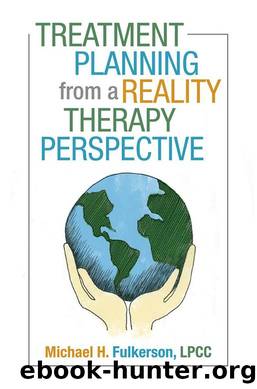Treatment Planning from a Reality Therapy Perspective by Michael H. Fulkerson LPCC

Author:Michael H. Fulkerson, LPCC [Michael H. Fulkerson, LPCC]
Language: eng
Format: epub
Publisher: iUniverse
Published: 2015-01-14T05:00:00+00:00
Freedom/Independence/Autonomy: The ability to move and choose or to stand on oneâs own feet.
Examples of treatment goals related to Freedom/Independence/Autonomy:
Goals:
1. Client will increase her/his level autonomy, freedom, and independence by obtaining a driverâs license.
2. Client will become more self-sufficient by holding a job for at least six months.
3. Client will demonstrate ten new coping skills to manage his/her emotions.
4. Client will report improving her/his self-talks.
5. Client will embrace fifteen minutes of solitude time each day for a period of thirteen weeks in order to improve her/his mental health.
6. Client will be able to develop his/her own achievement plans.
7. Client will be able to sleep in his/her own bed.
8. Client will draw three alternate strategies for managing her/his anxiety.
9. Client will develop sufficient computers skills to obtain employment.
10. Client will accept more responsibility for his/her actions by replacing his/her three favorite excuses with âIâ statements.
11. Client will demonstrate the ability to rethink rather than react by teaching the questioning process of reality therapy to at least three different people.
12. Client will improve independent decision-making skills by reporting three difference occasions in which he/she resolved conflict without violence.
13. Client will be able to resist negative peer pressure for a period of three months as reported and documented by client and service team.
14. Client will learn to self-evaluate, self-monitor, and self-regulate his/her behavior by graduating an anger-management program.
15. Using Peteâs Pathogram, client will report at least a 12 percent increase in her/his ability to fulfill her/his need for freedom/autonomy/independence.
16. Using a subjective units of distress (SUD) scale, client will report a 25 percent improvement in managing her/his level of anxiety.
17. Client will show improved mental health as evidenced by a child post-traumatic stress scale (CPSS) score no higher than fourteen.
Download
This site does not store any files on its server. We only index and link to content provided by other sites. Please contact the content providers to delete copyright contents if any and email us, we'll remove relevant links or contents immediately.
| Administration & Medicine Economics | Allied Health Professions |
| Basic Sciences | Dentistry |
| History | Medical Informatics |
| Medicine | Nursing |
| Pharmacology | Psychology |
| Research | Veterinary Medicine |
Bioenergetica by Alexander Lowen(1426)
The Child in You by Stefanie Stahl(1201)
No Bad Parts by Richard C. Schwartz(1170)
Noise: A Flaw in Human Judgment by Sunstein Cass R. & Sibony Olivier & Kahneman Daniel(1155)
The Data Detective by Tim Harford(1101)
Chatter by Ethan Kross(1026)
The Science of Rapid Skill Acquisition by Peter Hollins(870)
The Quantum Psychiatrist: From Zero to Zen Using Evidence-Based Solutions Beyond Medication and Therapy by Biswas Dona(832)
Freedom by Sebastian Junger(813)
The Montessori Baby by Simone Davies(789)
Maps of Meaning: The Architecture of Belief by Jordan B. Peterson(707)
The Science of Self-Learning: How to Teach Yourself Anything, Learn More in Less Time, and Direct Your Own Education (Learning how to Learn Book 1) by Peter Hollins(689)
Evolution Gone Wrong: The Curious Reasons Why Our Bodies Work by Alex Bezzerides(672)
Sadomasochism and the BDSM Community in the United States by Stephen K. Stein(656)
Anxiety For Dummies by Charles H. Elliott & Laura L. Smith(635)
Why Sex Doesn't Matter by Olivia Fane(627)
Disconnected by thomas Kersting(621)
Jung - The Key Ideas: Teach Yourself (TY Philosophy) by Ruth Snowden(595)
The Mechanics of Passions: Brain, Behaviour, and Society by Alain Ehrenberg(592)
